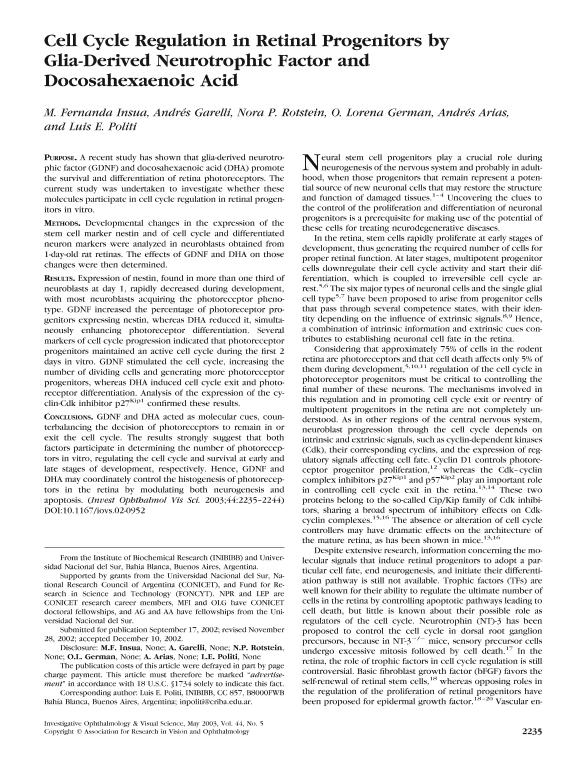Mostrar el registro sencillo del ítem
dc.contributor.author
Insúa, Maria Fernanda
dc.contributor.author
Garelli, Andres

dc.contributor.author
Rotstein, Nora Patricia

dc.contributor.author
German, Olga Lorena

dc.contributor.author
Arias, Andres Hugo

dc.contributor.author
Politi, Luis Enrique

dc.date.available
2018-07-24T19:53:51Z
dc.date.issued
2003-05
dc.identifier.citation
Insúa, Maria Fernanda; Garelli, Andres; Rotstein, Nora Patricia; German, Olga Lorena; Arias, Andres Hugo; et al.; Cell cycle regulation in retinal progenitors by glia-derived neurotrophic factor and docosahexaenoic acid; Association for Research in Vision and Ophthalmology; Investigative Ophthalmology & Visual Science; 44; 5; 5-2003; 2235-2244
dc.identifier.issn
0146-0404
dc.identifier.uri
http://hdl.handle.net/11336/53016
dc.description.abstract
PURPOSE. A recent study has shown that glia-derived neurotrophic factor (GDNF) and docosahexaenoic acid (DHA) promote the survival and differentiation of retina photoreceptors. The current study was undertaken to investigate whether these molecules participate in cell cycle regulation in retinal progenitors in vitro. METHODS. Developmental changes in the expression of the stem cell marker nestin and of cell cycle and differentiated neuron markers were analyzed in neuroblasts obtained from 1-day-old rat retinas. The effects of GDNF and DHA on those changes were then determined. RESULTS. Expression of nestin, found in more than one third of neuroblasts at day 1, rapidly decreased during development, with most neuroblasts acquiring the photoreceptor phenotype. GDNF increased the percentage of photoreceptor progenitors expressing nestin, whereas DHA reduced it, simultaneously enhancing photoreceptor differentiation. Several markers of cell cycle progression indicated that photoreceptor progenitors maintained an active cell cycle during the first 2 days in vitro. GDNF stimulated the cell cycle, increasing the number of dividing cells and generating more photoreceptor progenitors, whereas DHA induced cell cycle exit and photoreceptor differentiation. Analysis of the expression of the cyclin-Cdk inhibitor p27Kip1 confirmed these results. CONCLUSIONS. GDNF and DHA acted as molecular cues, counterbalancing the decision of photoreceptors to remain in or exit the cell cycle. The results strongly suggest that both factors participate in determining the number of photoreceptors in vitro, regulating the cell cycle and survival at early and late stages of development, respectively. Hence, GDNF and DHA may coordinately control the histogenesis of photoreceptors in the retina by modulating both neurogenesis and apoptosis.
dc.format
application/pdf
dc.language.iso
eng
dc.publisher
Association for Research in Vision and Ophthalmology

dc.rights
info:eu-repo/semantics/openAccess
dc.rights.uri
https://creativecommons.org/licenses/by-nc-sa/2.5/ar/
dc.subject
Glia-Derived Neutrophic Factor
dc.subject
Docosahexaenoic Acid
dc.subject
Retina Photoreceptor
dc.subject.classification
Otras Ciencias Biológicas

dc.subject.classification
Ciencias Biológicas

dc.subject.classification
CIENCIAS NATURALES Y EXACTAS

dc.title
Cell cycle regulation in retinal progenitors by glia-derived neurotrophic factor and docosahexaenoic acid
dc.type
info:eu-repo/semantics/article
dc.type
info:ar-repo/semantics/artículo
dc.type
info:eu-repo/semantics/publishedVersion
dc.date.updated
2018-07-11T14:04:09Z
dc.journal.volume
44
dc.journal.number
5
dc.journal.pagination
2235-2244
dc.journal.pais
Estados Unidos

dc.journal.ciudad
Rockville
dc.description.fil
Fil: Insúa, Maria Fernanda. Consejo Nacional de Investigaciones Científicas y Técnicas. Centro Científico Tecnológico Conicet - Bahía Blanca. Instituto de Investigaciones Bioquímicas de Bahía Blanca. Universidad Nacional del Sur. Instituto de Investigaciones Bioquímicas de Bahía Blanca; Argentina
dc.description.fil
Fil: Garelli, Andres. Consejo Nacional de Investigaciones Científicas y Técnicas. Centro Científico Tecnológico Conicet - Bahía Blanca. Instituto de Investigaciones Bioquímicas de Bahía Blanca. Universidad Nacional del Sur. Instituto de Investigaciones Bioquímicas de Bahía Blanca; Argentina
dc.description.fil
Fil: Rotstein, Nora Patricia. Consejo Nacional de Investigaciones Científicas y Técnicas. Centro Científico Tecnológico Conicet - Bahía Blanca. Instituto de Investigaciones Bioquímicas de Bahía Blanca. Universidad Nacional del Sur. Instituto de Investigaciones Bioquímicas de Bahía Blanca; Argentina
dc.description.fil
Fil: German, Olga Lorena. Consejo Nacional de Investigaciones Científicas y Técnicas. Centro Científico Tecnológico Conicet - Bahía Blanca. Instituto de Investigaciones Bioquímicas de Bahía Blanca. Universidad Nacional del Sur. Instituto de Investigaciones Bioquímicas de Bahía Blanca; Argentina
dc.description.fil
Fil: Arias, Andres Hugo. Consejo Nacional de Investigaciones Científicas y Técnicas. Centro Científico Tecnológico Conicet - Bahía Blanca. Instituto de Investigaciones Bioquímicas de Bahía Blanca. Universidad Nacional del Sur. Instituto de Investigaciones Bioquímicas de Bahía Blanca; Argentina
dc.description.fil
Fil: Politi, Luis Enrique. Consejo Nacional de Investigaciones Científicas y Técnicas. Centro Científico Tecnológico Conicet - Bahía Blanca. Instituto de Investigaciones Bioquímicas de Bahía Blanca. Universidad Nacional del Sur. Instituto de Investigaciones Bioquímicas de Bahía Blanca; Argentina
dc.journal.title
Investigative Ophthalmology & Visual Science

dc.relation.alternativeid
info:eu-repo/semantics/altIdentifier/url/https://iovs.arvojournals.org/article.aspx?articleid=2163508
dc.relation.alternativeid
info:eu-repo/semantics/altIdentifier/doi/http://dx.doi.org/10.1167/iovs.02-0952
Archivos asociados
